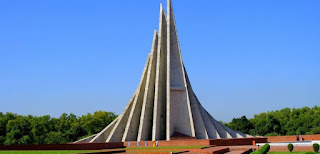 |
| Jatiyo Smriti Soudho |
Jatiyo Smriti Soudho is imperative landmark for Bangladesh's
history along these lines, Bangladesh Government was extremely mindful about
this landmark. The primary designs of this landmark were started after the
autonomy in 1972. However, because of numerous issues, it was postponed after
1972-1978. Yet, in 1978, an across the country plan rivalry was held in June for
the site choice, street and land advancement about this landmark. Among the 57
contenders Architect Syed Moinul Hossain's outline proposition was endorsed.
The principle structure, the counterfeit lake and different offices were
finished of this landmark in 1982.
This lovely complex is spread over a region of 34 hectares
(84 sections of land) and it is wrapped around by a green belt of 10 hectares
(24.7 section of land). This lovely condition makes this landmark exceptionally
appealing. The landmark tower is made by concrete and different structures and
asphalts are made by red blocks. This red blocks helps us about the blood to
remember the 3 million individuals, who relinquished their blood for the
freedom of Bangladesh. This landmark is created with 7 isosceles triangular
pyramid formed structures yet the center one being the tallest. The most
noteworthy purpose of the landmark is 150 feet. 7 isosceles triangular pyramids
remind us our seven Bir Sreshthos. This one of a kind course of action of the planes
has made a structure that appears to change its arrangement when seen from
various edges. A few mass graves and an excellent reflection water body are set
before this landmark. In the event that anyone goes into the complex through
the principle entryway, he or she can see the landmark pivotally. Be that as it
may, to achieve it one needs to stroll through various high points and low
points of asphalts and cross a simulated lake by a scaffold all these speak to
the battle for freedom.
The Public Works Department of the Government of Bangladesh
directed the development of the undertaking. In any case, this task was
developed in three times. The primary venture was associated with obtaining
land and building street for the task. It was in 1972. The cost of this
undertaking was 26 lacs. The second undertaking was in 1974-1982. The cost of
this task was 3.77 crores. This task was engaged with to assemble the mass
graves, asphalts, parking spots, helipad and so on. Furthermore, the third undertaking
was in August 1982. The cost of this task was 848.65 lacs. This undertaking was
engaged with to assemble the primary structure, aside from the counterfeit
lake, green belt, cafeteria, lodging and so on.